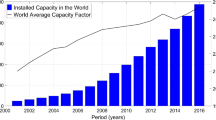Abstract
The power curve of a wind turbine grows exponentially as a function of wind-velocity if the measured wind-velocity varies between the cut-in velocity and the rated velocity. In this study, we propose an empirical, two-parameter explicit model of the power curve for a wind turbine. The model generalizes different turbine power curves and provides an easy estimate to compare various turbine characteristics. The energy analysis of the wind turbine is done using the (proposed) functional relationship and demonstrates how the capacity factor of a wind turbine varies with these empirical factors.





Similar content being viewed by others
References
Jangamshetti, S.H., Rau, V.G.: Site matching of wind turbine generators: a case study. IEEE Trans. Energy Convers. 14, 1537–1543 (1999)
Jangamshetti, S.H., Rau, V.G.: Normalized power curves as a tool for identification of optimum wind turbine generator parameters. IEEE Trans. Energy Convers. 16, 283 (2001)
Tai-Her, Y., Li, W.: A study on generator capacity for wind turbines under various tower heights and rated wind speeds using Weibull distribution. IEEE Trans. Energy Convers. 23, 592–602 (2008)
Albadi, M.H., El-Saadany, E.F.: Optimum turbine-site matching. Energy 35, 3593–3602 (2010)
Hu, S., Cheng, J.: Performance evaluation of pairing between sites and wind turbines. Renew. Energy 32(11), 1934–1947 (2007)
Pallabazzer, R.: Parametric analysis of wind siting efficiency. J. Wind Eng. Ind. Aerodyn. 91(11), 1329–1352 (2003)
Dialynas, E.N., Machias, A.V.: Reliability modelling interactive techniques of power systems including wind generating units. ArchivFuerElektrotechnik 72, 33–41 (1989)
Salameh, Z.M., Safari, I.: Optimum windmill-site matching. IEEE Trans. Energy Convers. 7, 669–676 (1992)
Justus, CG., Hargraves, WR., Yalcin, A.: Nationwide assessment of potential output from wind-powered generators. J. Appl. Meteorol. 15 (1976)
Giorsetto, P., Utsurogi, KF.: Development of a new procedure for reliability modeling of wind turbine generators. IEEE Trans. Power Apparatus Syst. 102, 134–143 (1983)
Pallabazzer, R.: Evaluation of wind-generator potentiality. Solar Energy 55, 49–59 (1995)
Mathew, S., Philip, G.S.: Advances in Wind Energy Conversion Technology. Springer, New York (2011)
Celik, AN.: Energy output estimation for small scale wind power generators using Weibull-representative wind data. J. Wind Eng. Ind. Aerodyn. 91, 693–707 (2003)
Chang, T.J., Tu, Y.L.: Evaluation of monthly capacity factor of WECS using chronological and probabilistic wind speed data: a case study of Taiwan. Renew. Energy 32, 1999–2010 (2007)
https://inlportal.inl.gov/portal/server.pt/community/wind_power/424. Accessed 2 August 2013
Acknowledgments
The author wishes to thank the reviewers of this article for their feedback, Dr. Anshu Bharadwaj, Executive Director, Center for Study of Science, Technology and Policy (CSTEP), Bangalore, India for his continuous support; Dr. Annapoorna Ravichander and Mr. Bishal Mazumdar, CSTEP, Bangalore, India for their help in creating this manuscript.
Author information
Authors and Affiliations
Corresponding author
Rights and permissions
About this article
Cite this article
Das, A.K. An empirical model of power curve of a wind turbine. Energy Syst 5, 507–518 (2014). https://doi.org/10.1007/s12667-013-0101-5
Received:
Accepted:
Published:
Issue Date:
DOI: https://doi.org/10.1007/s12667-013-0101-5




